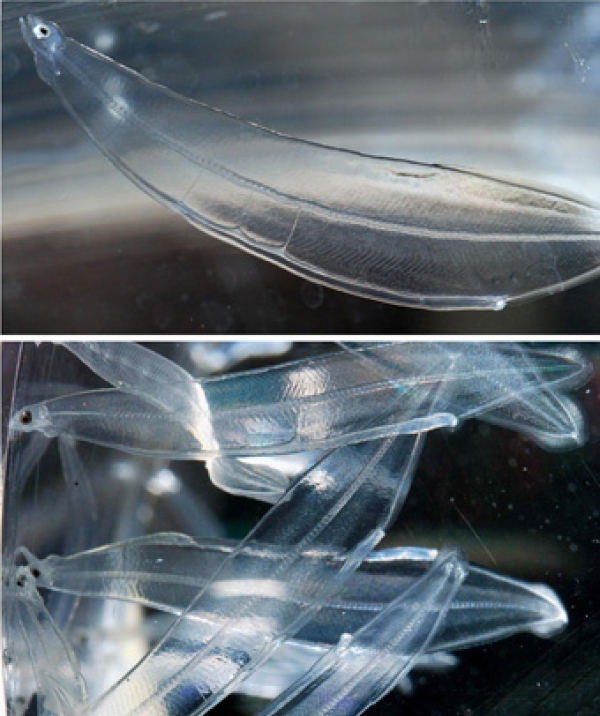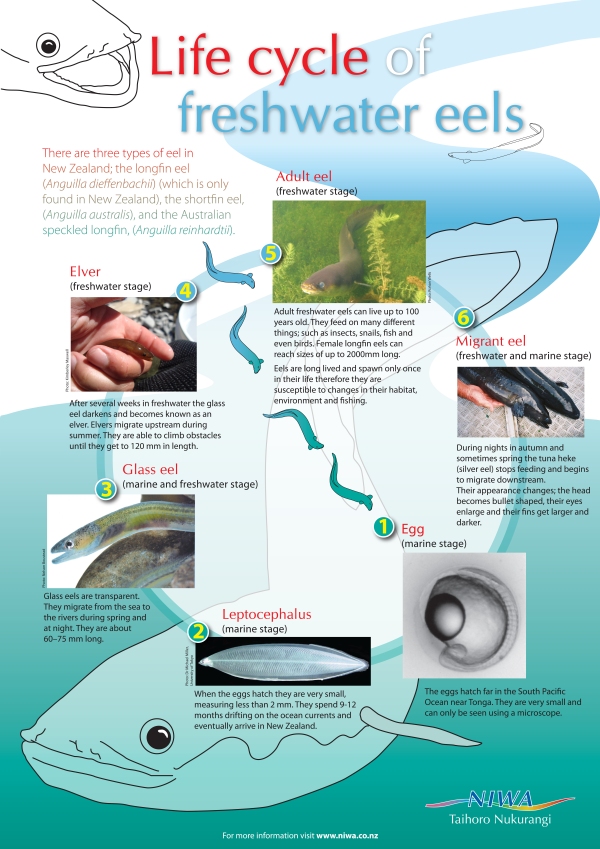Freshwater eels have an unusual life cycle which sees them travelling between the ocean, estuaries and freshwaters.
Although there are many stories and legends of tuna spawning in freshwater, what is certain is that all freshwater eels spawn at sea.
Starting life at sea but then migrating into freshwater is known as a catadromous life history.
Freshwater eels migrate thousands of kilometres into the Pacific Ocean to release eggs and sperm in a process called spawning.
During this migration, eels do not feed. The fertilised eggs then develop into larvae called leptocephalii, which travel back to New Zealand via ocean currents. Eels then enter our rivers as small juveniles that are known as glass eels.
As the glass eels migrate upstream they gradually become pigmented (or grow darker) and are more commonly known as elvers.
The adult tuna live for a relatively long time in rivers, lakes, wetlands, ponds and streams, eating and preparing themselves for when they are ready to begin their migration back out to sea.
When the migrants or tuna heke are ready to begin their long migration, some of their features change to help them on their journey.
Leptocephalii larvae
The flat and transparent larvae of tuna, known as leptocephalus (meaning leaf-shaped), hatch far out at sea. The exact location of the spawning grounds of New Zealand's tuna species are currently unknown.
Leptocephalii spend between 6 and 10 months in the plankton and drift back to the coast of New Zealand using the near-surface currents of the Pacific Ocean.
Thirteen shortfin tuna larvae have been captured to date during marine voyages. However, the longfin tuna remains the only species for which no larvae are known.
Once the leaf-shaped leptocephalii reach the continental shelf, between August and December, they transform into the more tubular, streamlined, transparent juvenile stage known as "glass eels" which are approximately 5.5 to 7.0 cm long.
The East Australian Current (EAC) is likely to be the main transport agent for the dispersal of larvae from spawning grounds in the tropics. The current flows in an anti-clockwise direction as part of the subtropical gyre in the South Pacific, centred near Fiji.
The EAC has a high degree of eddy variability affecting recirculation, potentially also influencing eel recruitment to New Zealand.
The intensity and persistence of recent El Ninos, as indicated by the Southern Oscillation Index (SOI), may have disrupted the EAC in favour of transporting A. reinhardtii to New Zealand.
References and further reading
Cairns, D. (1941). Life history of the two species of New Zealand freshwater eel. Part I. Taxonomy, age and growth, migration and distribution. New Zealand Journal of Science and Technology, Series B 23: 53-72.
Jellyman, D. (2005). Strange larval eel caught by Tangaroa. Water & Atmosphere 13(1): 6. http://www.niwa.co.nz/news-and-publications/publications/all/wa/13-1/news3
Jellyman, D.J. (2006). Tagging along when longfins go spawning. Water & Atmosphere 14(1): 24-25. http://www.niwa.co.nz/news-and-publications/publications/all/wa/14-1/longfins
Jellyman, D.J., Bowen, M.M. (2009). Modelling larval migration routes and spawning areas of anguillid eels of New Zealand and Australia. American Fisheries Society Symposium 69: 255-274.
Kuroki, M., Aoyama, J., Miller, M. J., Watanabe, S., Shinoda, A., Jellyman, D. J., Feunteun, E., Tsukamoto, K. (2008). Distribution and early life-history characteristics of anguillid leptocephali in the western South Pacific. Marine and Freshwater Research 59: 1035-1047. http://www.publish.csiro.au/paper/MF08041.htm
Miller, M.J. (2009). Ecology of Anguilliform Leptocephali: Remarkable Transparent Fish Larvae of the Ocean Surface Layer. Aqua-BioSci. Monogr. 2(4): 1-94.
Miller, M.J, Tsukamoto, K. (2004). An introduction to leptocephali: Biology and identification. Ocean Research Institute, University of Tokyo, Tokyo.
Miller, M.J., Kimura, S., Friedland, K.D., Knights, B., Kim, H., Jellyman, J.D., Tsukamoto, K. (2009). Review of ocean-atmospheric factors in the Atlantic and Pacific oceans influencing spawning and recruitment of anguillid eels. In: Haro, A., Avery, T., Beal, K., Cooper, J., Cunjak, R., Dadswell, M., Klauda, R., Moffitt, C., Rulifson, R., Smith, K. (eds). Challenges for Diadromous Fishes in a Dynamic Global Environment. American Fisheries Society Symposium 69. Bethesda, Maryland. pp. 231-249.
Schmidt, J. (1909). Remarks on the metamorphosis and distribution of the larvae of the eel (Anguilla vulgaris Turt.). Meddr Kommn Havunders. Ser. Fisk. 3(3): 1-17.
Tsukamoto, K., Yamada, Y., Okamura, A., Tanaka, H., Miller, M.J., Kaneko, T., Horie, N., Utoh, T., Mikawa, N., Tanaka, S. (2009). Positive buoyancy in eel leptocephali: an adaptation for life in the ocean surface layer. Marine Biology 156: 835-846.



